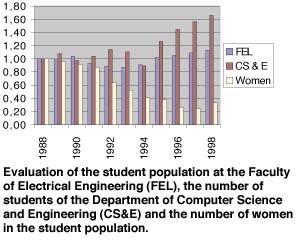IT Training in a Changing Society
by Josef Kolar
The process of changes in the countries of Central and Eastern Europe has removed barriers in their political, economical, and social life. In the Czech Republic, we experience the creation of a new environment in which both industrial companies and educational institutions are subject to conditions of an open market. This article presents some hypotheses concerning recent trends in student population at one of the faculties of the Czech Technical University in Prague.
The Department of Computer Science and Engineering (CS&E) at the
Faculty of Electrical Engineering was the first offering a comprehensive
university education in IT in the former Czechoslovakia. The study
program has always been a balanced mixture of software- and hardware-oriented
courses, so that the graduates were attractive to a relatively
wide sector of the job market.
After the removal of the communist regime, the computer market
opened to a massive import of technologies whose supply was strictly
controlled before. Free import eliminated the need of technologically
obsolete IT systems produced in the former COMECOM countries.
and caused a peak demand for IT personnel capable of a quick adoption
to new technologies. Western companies started to build their
local offices hiring mostly Czech personnel since they were cheaper
and knew the local environment. Graduates from the Department
of CS&E were some of the most successful in getting such jobs
and in many cases they gradually reached the top positions in
the Czech branches of many important companies (as eg IBM, Microsoft,
Oracle, etc.). Apart from this, the continuous development in
IT and telecommunications has been attracting young people to
enroll for computer studies at the department.
The figure shows how three indicators we consider interesting
have been evolving in the last decade. They represent the overall
student population of the faculty, the number of students of CS&E,
and the number of women in the student population. The indicator
values have been normalized in order to compare their trends (the
actual starting values are 4037, 362, and 293, resp.). We see
that after an initial stagnation, the population grows yet not
that quickly as the numbers of CS&E students. The difference could
have been even more remarkable if all students applying for the
CS&E study program had been accepted, which is not possible due
to limited space and personnel capacity of the department. While
quite satisfactory for us, this situation reflects a serious drain-off
effect to other study programs and departments both in student
numbers and quality.

The critically decreasing number of women is something the university
is not pleased with even though there is probably no chance for
a technical university to achieve a close-to-balanced population
with respect to sex. The decrease in women population is even
more alarming if percentage is considered. The student population
had 7.3% women in 1988, but only 1.6% in 1997. We tried to formulate
possible hypothesis as to the reasons for this situation.
Girls do not like computers - The way children get the first exposure
to IT is favoring boys. It is not only that most computer games
are competition-oriented (fighting, war-games) but the technical
aspects of the issue attract more boys than girls. More publicity
is needed to stress the fact that there is enough space in IT
applications for creativity, cooperation, and social communication,
both in usage and in design (as eg in WWW pages or human-computer
interface), in which the female factor can be fully appreciated.
Girls do not like electrical engineering (EE) - Even accepting
that technical disciplines (and specifically EE) are perhaps more
male-attractive, how to explain the latest trend that has led
from a modest 7.3% to an almost complete female extinction from
the student body? Our hypothesis is that nowadays, there is a
richer offering in the educational market so that most girls actually
select study programs what they like more.
Another fact derived from indicators that are not depicted in
the diagram is that the average time needed to graduate (if ever)
has grown remarkably. Our hypothesis, whose verification would
need more data, is that the reason is not the difficulty of the
program but mostly the deliberate decision of the students. Since
they do not pay any fees and have important advantages, they often
stay îstudyingî while actually working for some company. The university
thus offers a shelter for a smooth start into their professional
life.
Conclusions
There are many traditions and myths in university life that, surprisingly,
quickly disappear when the society experiences a deep social transition.
Although some of the changes are positive and some others are
inevitable, we still have a chance to influence them provided
that we find the real reasons.
Please contact:
Josef Kolar - CRCIM
Tel: +420 2 2435 7403
E-mail: kolar@fel.cvut.cz
